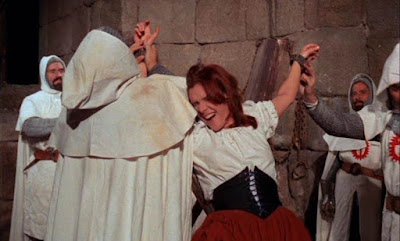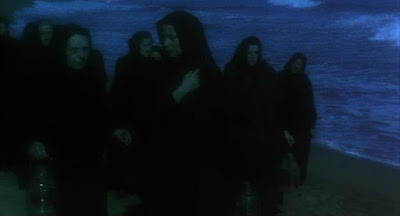I Walked with a Zombie
(1943) Directed by the master of atmosphere, Jacques Tourneur, I Walked with a Zombie is a compelling,
beautifully shot mood piece. Nurse Betsy Connell (Frances Dee) travels to the
West Indies to care for a woman in a semi-catatonic state. The woman’s moribund
husband, Paul (Tom Conway) runs a sugar plantation, and wallows in cynicism and
self-pity (“There’s no beauty here, only death and decay.”). Meanwhile, Paul’s
half-brother Wesley (James Ellison) chooses to die a slow death with alcohol.
As Betsy becomes embroiled in the brothers’ dysfunctional behavior, she begins
to see a link between the family and voodoo rituals on the island. Hoping to
find a cure for Paul’s wife, she delves deeper into the ancient practices, and
discovers there’s more to the rituals than simple native superstitions. Text
and subtext intermingle seamlessly in a story that marries tangible horrors
with psychological torment.
Rating: ****. Available on DVD
Dracula’s Daughter
(1936) This middling attempt to cash in on Tod Browning’s original picks up
(sort of) where the first film left off. Dracula is dead, but his curse lives
on in his “daughter,” a victim from a century past. Edward Van Sloan reprises
his role as Dr. Van Helsing, who’s accused of murder after the bodies of Dracula
and Renfield are discovered. Psychiatrist Jeffrey Garth (Otto Kruger) aims to
clear Van Helsing’s name, but becomes entranced by a mysterious patient Contessa
Marya Zeleska (Gloria Holden). Holden is excellent as the tragic title
character, who’s powerless to escape her blood-sucking destiny. Too bad the
story around her is so weak. Vampire fans might consider looking elsewhere for
their thrills, but Universal horror enthusiasts should give it a look.
Rating: **½. Available on DVD
Zombies on Broadway
(1945) A mob boss (played by Sheldon Leonard of It’s a Wonderful Life fame) runs a zombie-themed show in New York.
The only problem is, he has no real zombies. He sends two lackeys to the
Caribbean to find the real deal (or else!). They run into Professor Renault
(Bela Lugosi), a mad scientist conducting zombie experiments on a remote island.
The pair of Abbott & Costello copycats (well, more like Costello &
Costello) help a dame in trouble, and madcap hijinks ensue, with forced comic
bits that appear to have been recycled from Three Stooges shorts. Although the
film evokes more indifference than laughter, it might be worth watching once
for the oddball premise. Fun trivia: watch for two actors who essentially
reprise their roles from I Walked with a
Zombie: Darby Jones as a pop-eyed zombie, and Sir Lancelot (No, really) as
a calypso singer.
Rating: **½. Available on DVD
The Children (1980)
You might question your sanity if you stumble on this obscure, no-budget horror
flick. Contaminated soil from a nearby
nuclear power plant somehow causes a school bus full of kids to become zombies
with black fingernails. Anyone who receives a hug from them dies instantly. The
small-town sheriff’s office consists of two cops, who never think to call for
backup when the busload of kids is missing. It might be worth a look, as long
as you’re prepared for loads of unintentional comedy, instead of scenes of
terror.
Rating: **½. Available on DVD
Fright Night Part II
(1988) Roddy McDowall and William Ragsdale reprise their roles as Peter Vincent
and Charley Brewster in this lazy sequel to the iconic 1985 original. The
filmmakers do little more than duplicate key scenes, poorly. There’s some clumsy
humor, but it’s not integrated into the story very well. Charley just isn’t
very likeable this time around – whatever dorky charms he had in the first
movie are lost here. The plot, such as it is, involves Jerry Dandridge’s sister
(along with her dull undead entourage), who returns for revenge against Charley.
It’s fun to see McDowell again, but he doesn’t have that much to do. The whole
affair seems lackluster, and half-hearted. Even Brad Fiedel’s score seems by
the numbers, compared to his previous effort. Where’s Evil Ed when you need
him?
Rating: **. Available on DVD (Out of print)
Psychomania (1973)
In this odd little movie that couldn’t, obnoxious bikers die, becoming
obnoxious undead bikers. In the crazy premise the bikers become immortal after
a spell is cast. Under the spell’s conditions, they must kill themselves, and
they must believe they’ll return from the dead. One of the bikers is buried,
sitting on his bike, and later emerges from the grave without a speck of dirt.
After the bikers achieve their dream, they find nothing better to do than ride
through a village square and create mayhem in a grocery store. Who knew
immortality could be so dull?
* On a tragic note, star George Sanders committed suicide
shortly after filming. According to the DVD documentary, this was the last film
he watched. Lesson learned: watch at your own peril.
Rating: **. Available on DVD




























